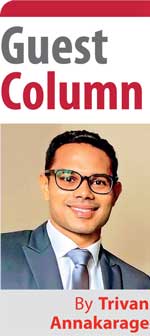Sunday Dec 14, 2025
Sunday Dec 14, 2025
Thursday, 14 October 2021 00:00 - - {{hitsCtrl.values.hits}}

RCEP is geared towards creating a tight-knit market where member states can benefit from imports and exports with minimum trade barriers
 The Regional Comprehensive Economic Partnership (RCEP) has been signed into operation and is gaining traction owing to its magnitude and composition.
The Regional Comprehensive Economic Partnership (RCEP) has been signed into operation and is gaining traction owing to its magnitude and composition.
As of 2020, the collective Gross Domestic Product (GDP) of all member states in the regional trade bloc amounted to 30% of global GDP ($ 38.81 trillion)1. This figure is larger than the GDP of both NAFTA 2.0 ($ 22.20 trillion) and the European Union ($ 15.17 trillion) combined2. Moreover, the 15 member states represent a cumulative population of 2.2 billion people, amounting to 30% of world population3.
Thus, RCEP is currently the largest trade bloc to have existed in the history of multilateralism. At a time when the concept of multilateralism itself is brought into question, a regional trading bloc of such magnitude gives credence to the potential of RECP.
Background
Signed on 15 November 2020 when Vietnam hosted a virtual ASEAN summit4, RCEP represents three regions – Southeast Asia, Far East Asia, and Australia and Oceania. The Southeast Asian nation-states include all 10 ASEAN member countries namely, Indonesia, Thailand, Myanmar, Philippines, Singapore, Malaysia, Brunei, Cambodia, Laos and Vietnam. The Far East Asian countries include China, Japan and South Korea. The two countries from Australia and Oceania are Australia and New Zealand.
RCEP is a key milestone for ASEAN since it was instrumental in its formation, and was able to bring China into the grouping without creating a fallout with Japan, South Korea and Australia, that experience tensed relations with Beijing.
RCEP is geared towards creating a tight-knit market where member states can benefit from imports and exports with minimum trade barriers. In addition to trade in goods and services, other focus areas include investment, intellectual property, dispute settlement and e-commerce followed by small and medium enterprises5. The latter is a very important focus area since SMEs comprise over 90% of business establishments in the 15 member-countries6.
Within the first 20 years of the trading bloc’s existence, RCEP wishes to eliminate 90% of tariff imports between signatories7 8. Furthermore, with the increasing traffic in the online market space and innovation that takes place in these regions, RCEP would establish common rules for e-commerce and intellectual property rights.
The trade bloc has been criticised for not being explicit on labour laws, environmental protection and government subsidies9. Nevertheless, analysts argue that initiatives spearheaded by ASEAN begin with a broad vision and are gradually streamlined and achieved with necessary and timely amendments as time progresses. This strategy has contributed to the longevity and relevance of ASEAN and would hopefully do the same for RCEP.10
China’s prospects
The advanced democratic economies in RCEP (Japan, South Korea and Australia) are close allies of the United States. The recently invigorated military alliance; Quadrilateral Security Dialogue (QUAD) results in US, Japan, India and Australia’s joint effort to curtail China’s growing military prowess in the Indian Ocean and Asia Pacific. Against these developments RCEP becomes more intriguing as the United States is not part of it. This creates an absence of a power balance with China the most influential country in the grouping in terms of its economic and military might.
military might.
If member countries work cohesively, RCEP would pull the economic centre of gravity closer to the East11 12. The possibility of such a favourable outcome has therefore aided in softening the relationship between these three countries and China for a much larger purpose of economic prosperity.
The other trade bloc that would have rivalled RCEP was the Trans-Pacific Partnership (commonly referred to as TPP) which was signed by 14 countries in 2016. Yet President Donald Trump withdrew USA from the trade bloc in 2017. This paved the road for the creation of RCEP due to the lack of momentum and cohesiveness in TPP13. Today, nine countries have membership in both RCEP and TPP.
In November 2019, New Delhi decided to stay out of RCEP, sending out mixed signals. Prime Minister Modi outlined that the trading bloc did not address India’s need to commit to such an agreement.14 Potential adverse effects to domestic industrial and agricultural sectors from Chinese-manufactured goods and dairy products from Australia and New Zealand were cited as reasons15 16. Yet experts predict Indian pharmaceuticals, cotton yarn and services industries would have benefitted enormously given the size of the market available17.
If there was a vision for RCEP to become a mighty economic force from the East, this may have fallen short since India is the third largest economy in Asia after China and Japan. This may have been the reason why RCEP has provided flexibility to India to become a member-state in the future whenever New Delhi deems it fit18. However, Singapore’s former representative to the United Nations, Kishore Mahbuban, stated that the absence of both USA and India in this trace bloc has paved the way for China to proceed with its geopolitical ambitions and to create a unanimous economic ecosystem centred around RCEP where China would be its nucleus19.
Prospects and concerns
It is clear that China, Japan and South Korea will reap the most out of this trade bloc20. For China, RCEP leverages its position as a world power and invigorates her geopolitical ambitions for world ascendency through the Belt and Road Initiative. Moreover, it provides China with the opportunity to tighten her cultural affinity with a growing ethnic Chinese community across Southeast Asia.
For Japan and South Korea, RCEP would be a new market to export their high-end industrial products as the quality of life in ASEAN and its share of billionaires is on the rise. It is an opportunity to enhance soft-power diplomacy in ASEAN, Australia and New Zealand through their respective entertainment industries.
For Australia and New Zealand, RCEP is beneficial for an economic recovery strategy from COVID-19 as they access new export markets and explore investment in Southeast Asia21 22. RCEP would provide greater access to developed economies for Southeast Asian countries such as Indonesia, Thailand, Myanmar, Cambodia and Laos whose economies largely depend on exports of finished garments, agricultural produce and commodities23. Countries such as Vietnam, Philippines and Malaysia would benefit from further investments in the tech industry.
RCEP would have a less impact on Singapore and Brunei since these countries have already established strong trade relations with the advanced economies of Far East Asia, and Australia and Oceania. If all member nation-states are equally optimistic in the success of this trade bloc, RCEP might gradually bring about a solution to the ongoing disputes in the South China Sea and East China Sea. This is too early to judge though.
A major concern is that since signing the agreement in 2020, not all member states have ratified the treaty. Currently only four countries – China, Japan, Singapore and Thailand – have ratified the treaty. The latter was the first to ratify. This is a clear indication that there is opposition to this bloc domestically in these countries where ratification is pending. It must be taken into account that many countries in South Asia have a booming tech industry.
RCEP might be a threat to this domestic industry due to flooding of low cost but equal/better quality Chinese imports. Further integration with the Chinese economy would mean Tokyo and Canberra being unable to fully commit themselves to supporting Washington’s geopolitical rivalries against Beijing. This would be detrimental to US influence over Southeast and Far East Asia.
The gradual ratification and operationalisation of RCEP will undoubtedly lead to an economic revolution that has the potential to create a model for regional cohesiveness further into the 21st century.
Footnotes
1New Zealand Foreign Affairs & Trade (2021). Regional Comprehensive Economic Partnership. Available at https://www.mfat.govt.nz/en/trade/free-trade-agreements/free-trade-agreements-concluded-but-not-in-force/regional-comprehensive-economic-partnership-rcep/rcep-overview
2BBC News (2020). RCEP: Asia Pacific Countries form the largest trading bloc. Available at https://www.bbc.com/news/world-asia-54949260
3Shotaro Tani (2020). India stays away from RCEP talks in Bali. Nikkei Asia. Available at https://asia.nikkei.com/Economy/Trade/India-stays-away-from-RCEP-talks-in-Bali
4CNA (2020). Asia-Pacific nations sign world’s largest trade pact RCEP. Available at https://www.channelnewsasia.com/news/business/rcep-trade-pact-asean-summit-singapore-china-13534960
5Laura Zhou (2020). Explainer: What is RCEP and what does an Indo-Pacific free trade deal offer China? South China Morning Post. Available at https://www.scmp.com/news/china/diplomacy/article/3109436/what-rcep-and-what-does-indo-pacific-free-trade-deal-offer
6Association of Southeast Asian Nations (2021). Regional Comprehensive Economic Partnership. Available at https://asean.org/?static_post=rcep-regional-comprehensive-economic-partnership
7Ibid^5
8Ibid^6
9Keith Bradsher & Anna Swanson (2020). China-led Trade Pact is Signed, in Challenge to U.S. The New York Times. Available at https://www.nytimes.com/2020/11/15/business/china-trade-rcep.html
10Peter Petri & Michael Plummer (2020). RCEP: A new trade agreement that will shape global economic and politics. Brookings. Available at https://www.brookings.edu/blog/order-from-chaos/2020/11/16/rcep-a-new-trade-agreement-that-will-shape-global-economics-and-politics/
11CNA (2020). US being left behind after Asia forms world’s biggest trade bloc RCEP: US Chamber. Available at https://www.channelnewsasia.com/news/asia/rcep-us-chamber-of-commerce-left-behind-asia-economy-trade-13576598
12Amy Gunia (2020). Why the U.S. Could be the Big Loser in the Huge RCEP Trade Deal between China and 14 Other Countries. Time. Available at https://time.com/5912325/rcep-china-trade-deal-us/
13Charles Riley (2017). Trump’s decision to kill TPP leaves door open for China. CNN. Available at https://money.cnn.com/2017/01/23/news/economy/tpp-trump-china/
14Ibid^15
15ET Bureu (2019). India decides to opt out of RCEP, says key concerns not addressed. The Economic Times. Available at https://economictimes.indiatimes.com/news/economy/foreign-trade/india-decides-to-opt-out-of-rcep-says-key-concerns-not-addressed/articleshow/71896848.cms
16Business Standard (2020). What is RCEP? Available at https://www.business-standard.com/about/what-is-rcep
17Ibid^15
18Bangkok Post (2020). What happens now the RCEP trade deal has been signed? Available at https://www.bangkokpost.com/business/2020503/what-happens-now-the-rcep-trade-deal-has-been-signed-
19Kishore Mahbubani (2021). Why Attempts to Build a New Anti-China Alliance Will Fail. Foreign Policy. Available at https://foreignpolicy.com/2021/01/27/anti-china-alliance-quad-australia-india-japan-u-s/
20Ibid^2
21Qu Caiyun (2020). Australia needs Southeast Asia for market, not politics. Global Times. Available at https://www.globaltimes.cn/content/1203633.shtml
22Ibid^1
23Heimkhemra Suy & Phnom Penh (2021). How RCEP benefits Cambodia in the long term. East Asia Forum. Available at https://www.eastasiaforum.org/2021/02/13/how-rcep-benefits-cambodia/
The writer is an Independent Researcher in International Relations and could be reached via email at [email protected]